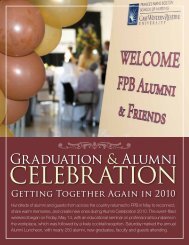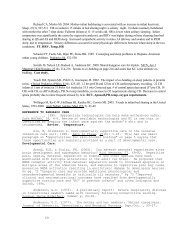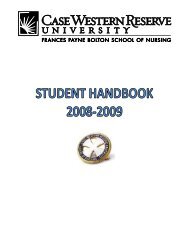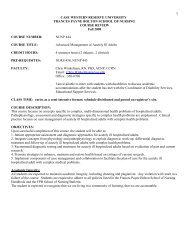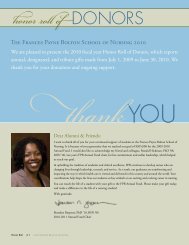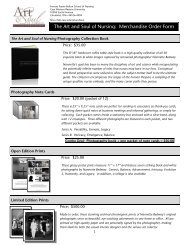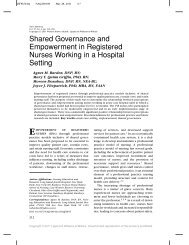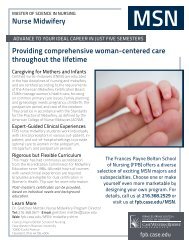Kangaroo Care BIBLIOGRAPHY Develope - Frances Payne Bolton ...
Kangaroo Care BIBLIOGRAPHY Develope - Frances Payne Bolton ...
Kangaroo Care BIBLIOGRAPHY Develope - Frances Payne Bolton ...
Create successful ePaper yourself
Turn your PDF publications into a flip-book with our unique Google optimized e-Paper software.
Ogi S, Arisawa K, Takahashi T, Akiyama T, Goto Y, Fukuda M, Saito H. 2001. The developmental effects of<br />
an early intervention program for very low birthweight infants. No To Hattatsu, 33 (1), 31-36. KC group got NBAS as<br />
intervention at 40 weeks PCA and then 44 wks (or may be from 38-44 wks for treatment) of KC starting at 38 weeks<br />
PCA. NBAS used at 44 wks, Bayley at 12 months. KC group scored higher on orientation, motor performance, state<br />
range & regulation tasks, supplementary on NBAS, lower scores in intensity and higher scores in Mood on <strong>Care</strong>y at 6<br />
months; at 12 month KC infants had higher Bayley Mental and Motor Scales. KC promotes neonatal behavioral<br />
organization and developmental outcome over 1 st year of life. Development, NBAS, Temperament. Longitudinal<br />
non-randomized as KC grp compared to historical control.<br />
Olausson H, Lamarre Y, Backlund H, Morin C,Wallin BG, Starck G, Elholm S, Strigo I, Worsley K, Vallbo<br />
AB, Bushnell MC. (2002). Unmyelinated tactile afferents signal touch and project to insular cortex. Nature<br />
Neuroscience 5 (sept). (9), 900-904. Human hairy skin has dual tactile innervation: fast conducting myelinated afferent<br />
fibers, and slow conducting unmyelinated (C)afferents that respond to light, caressing touch. Activation of C tactile (CT)<br />
afferents produced faint sensation of pleasant touch. Activation of CT fibers in skin activate the insular cortex (limbic<br />
system), not somatosensory areas of S1 and S2. CT is a system for limbic touch that underlies the emotional, hormonal,<br />
and affiliative responses to caress-like, skin-to-skin contact between individuals. Touch physiology. KC as pleasant<br />
experience.<br />
Ortman BL, Schmidt CL (1999).The Effect of <strong>Kangaroo</strong> <strong>Care</strong> on the Development of the Preterm Infant.<br />
Doctoral Dissertation from North Georgia College and State University. Available from Dr. Sherri Williams,<br />
Dissertation chair, Dept. of Physical Therapy. Barnes Hall, R. A-8, Dhlonega, GA 30597. 706-864-1969. A randomized<br />
trial of 5 KC and 9 routine parental holding of 27-32 wk PCA prematures. Kcers got 30 min/day x 4days/wk x 4 wks.<br />
Control got adlib parental visiting and holding x 4 wks. At end of 4 th week, no differences between groups on weight<br />
gain, Test of Infant Motor Performance, and Maternal Attachment Inventory and length of stay – but KC infants had<br />
significantly lower PCAs at entry. PT, RCT, MOTOR DEV, Maternal attachment, Lenth of stay, wgt gain<br />
Page, J. (1995). <strong>Kangaroo</strong> <strong>Care</strong>: Enhancing infant and parent well-being in the NICU. Perinatal Newsletter,<br />
12(1), 5-8. Provides limited review of KC (does not identify all studies, such as Ludington-Hoe’s 1992 paternal KC<br />
study)and then talks about Page’s proposed study of cardiorespiratory effects with Canadian infants. Does include<br />
Protocol for KC. PROTOCOL.<br />
Pagliotti F, Anderson GC. (1999). Don’t manage third stage. J. Nurse-midwifery, 44. 423-424.<br />
Parikh TB, Udani RH, Nanavati RN & Rao S. 2004. <strong>Kangaroo</strong> Mother <strong>Care</strong> Initiative in India – Where are<br />
We? Presentation at “Workshops on KMC at Neoncon 2004. XXIV NNF Annual Convention at Chandigarh,<br />
28October, 2004” Available from file://E:\<strong>Kangaroo</strong>Mother<strong>Care</strong>Initiative(KMCI)..htm. A pretest-posttest study of<br />
knowledge among 95 participants (65 pediatric and ob nurses, 30 pediatricans and obstetricians who were not doing KC<br />
at their institutions) All were given one day skill-based awareness program. Given questionnaire the morning of the<br />
program and posttest questionnaire at end of the day. Minority participants had heard of KMC, knowledge improved<br />
significantly after the one day class on components of KMC, benefits of KMC, KMC adaptation, thermoregulation in<br />
newborns, growth in preterms, preterm milk, monitoring of baby, discharge criteria, and KMC follow-up, but only 80%<br />
of participants knew one area at end of day, so authors concluded that present knowledge about preterm, LBW babies<br />
and KMC is unsatisfactory in Mumbai (Bombay) and that more education is needed. Descriptive, Preterm, 3 rd world,<br />
doctors and nurses knowledge (Not yet on charts)<br />
Parker L, Anderson GC. (2002) <strong>Kangaroo</strong> (skin-to-skin) care for adoptive parents and their critically ill preterm<br />
infant. MCN, Am J Mat Child Nurs, 27 (4), 230-232. KC began DAY 3 of five days of ventilation for a 917 gr infant.<br />
Adoptive parents both felt immediate and intense connection and began to know infant during KC. VENT KC<br />
ADOPTIVE KC. End of life KC? Also reported in Anderson, Dombrowski, & Swinth, 2001.<br />
71



